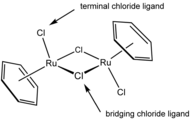Bridging ligand

In
In naming a complex wherein a single atom bridges two metals, the bridging ligand is preceded by the Greek letter
List of bridging ligands
Virtually all ligands are known to bridge, with the exception of amines and ammonia.[3] Common bridging ligands include most of the common anions.
| Bridging ligand | Name | Example |
|---|---|---|
| OH− | hydroxide | [Fe2(OH)2(H2O)8]4+, see olation |
| O2− | oxide | [Cr2O7]2−, see polyoxometalate
|
| SH− | hydrosulfido | Cp2Mo2(SH)2S2 |
| NH−2 | amido |
HgNH2Cl |
| N3− | nitride | [Ir3N(SO4)6(H2O)3]4−, see metal nitrido complex |
| CO | carbonyl |
Fe2(CO)9, see bridging carbonyl |
| Cl− | chloride | halide ligands
|
| H− | hydride | B2H6 |
| CN− | cyanide | approx. Fe7(CN)18 (prussian blue), see cyanometalate |
| PPh−2 | diphenylphosphide | see transition metal phosphido complexes |
Many simple organic ligands form strong bridges between metal centers. Many common examples include organic derivatives of the above inorganic ligands (R = alkyl, aryl):
Examples
- Compounds and complexes with bridging ligands
-
In this ruthenium complex ((benzene)ruthenium dichloride dimer), two chlorideligands are terminal and two are μ2 bridging.
-
Pyrazine is a bridging ligand in this diruthenium compound, called the Creutz–Taube complex.
-
In the cobalt cluster Co3(CO)9(CtBu), theCtBuligand is triply bridging, although this aspect is typically not indicated in the formula.
-
In triiron dodecacarbonyl, two CO ligands are bridging and ten are terminal ligands. The terminal and bridging CO ligands interchange rapidly.
-
InNbCl5, there are two bridging and eight terminal chloride ligands.
-
The cluster [Au6C(PPh3)6]2+ features a μ6-carbide ligand, although again, the designator "μ" is not usually used.
-
In rhenium trioxide, the oxide ligands are all μ2. These oxide ligands "glue" together the metal centres.
-
In the case of ZrCl4, there are both terminal and doubly bridging chloride ligands.
-
In rhodium(II) acetate, the four acetate groups are bridging ligands.
-
In VO(HPO4)·0.5H2O, pairs of vanadium(IV) centers are bridged by water ligands.[4]
Bonding
For doubly bridging (μ2-) ligands, two limiting representation are 4-electron and 2-electron bonding interactions. These cases are illustrated in main group chemistry by [Me2Al(μ2-Cl)]2 and [Me2Al(μ2-Me)]2. Complicating this analysis is the possibility of metal–metal bonding. Computational studies suggest that metal-metal bonding is absent in many compounds where the metals are separated by bridging ligands. For example, calculations suggest that Fe2(CO)9 lacks an iron–iron bond by virtue of a 3-center 2-electron bond involving one of three bridging CO ligands.[5]

Bridge-terminal exchange
The interchange of bridging and terminal ligands is called bridge-terminal exchange. The process is invoked to explain the fluxional properties of
- Co2(μ-CO)2(CO)6 ⇌ Co2(μ-CO)2(CO)4(CO)2
- (C5H5)2Fe2(μ-CO)2(CO)2 ⇌ (C5H5)2Fe2(μ-CO)2(CO)2
These dynamic processes, which are degenerate, proceed via an intermediate where the CO ligands are all terminal, i.e. (CO)4Co−Co(CO)4 and (C5H5)(CO)2Fe−Fe(CO)2C5H5.
Polyfunctional ligands
Polyfunctional ligands can attach to metals in many ways and thus can bridge metals in diverse ways, including sharing of one atom or using several atoms. Examples of such polyatomic ligands are the oxoanions
See also
- Bridging carbonyl
References
- ISBN 0-85404-438-8. pp. 163–165. Electronic version.
- PMID 14966876.
- PMID 12206689.
- ^ PMID 23047247.
- .






![The cluster [Au6C(PPh3)6]2+ features a μ6-carbide ligand, although again, the designator "μ" is not usually used.](http://upload.wikimedia.org/wikipedia/commons/thumb/5/5f/Au6C%28PPh3%296.png/138px-Au6C%28PPh3%296.png)



![In VO(HPO4)·0.5H2O, pairs of vanadium(IV) centers are bridged by water ligands.[4]](http://upload.wikimedia.org/wikipedia/commons/thumb/9/95/VO%28HPO4%290.5H2O.tif/lossless-page1-185px-VO%28HPO4%290.5H2O.tif.png)